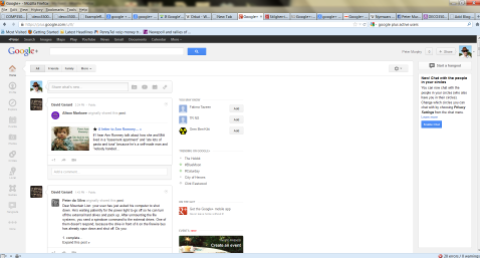Posted by: pkmurphy 11 years, 7 months ago
Note: this blog post was the seed for an assignment later that semester. To quote the instructions for the subject:
This assessment takes the form of a structured article which reflects on the design of social and mobile computing applications by using the specific context of one of the social & mobile encounters posted in the class blogs as a starting point.
I am thinking of adding the assignment to this site.
Some of my fellow students have blogged about Google+, so I thought I would pay it a revisit. Upon (re)viewing it, my reaction was "It's so empty." From the screenshot below, it appears to be missing some layout; the right hand side of the page has been left fallow. But Google+ is empty in other senses of the word. It's missing the personal content that I want to read, and missing the people to provide it.
I felt Google+ was extremely underutilised, but wanted numbers to confirm my impression. I decided to perform my own rough statistical analysis. I counted how many "friends" I had on each network, and also how many people had posted something – a photo, a link, anything at all – in the last 24 hours. I have 148 "Friends" on Facebook, and 45 "Friends"/"Family" on Google+ – a ratio of roughly 4:1. In the last day, I had 24 of my acquaintances do something – anything at all – on Facebook. The equivalent on Google+? One. The plural of anecdote isn't data, and perhaps my sample is biased by not working at Google, or living in Silicon Valley, or even the United States. But from an Antipodean perspective, it looks Google+ is not getting the bums on seats.
Google+ seems to suffer from some of Grudin's Eight Challenges for Developers. Choosing three in particular:
- Disparity of work versus benefit: it is very easy to get a Google+ page; just sign up to one of the many services under the Google umbrella. That's why I have quite a few Google+ "friends"; they had Gmail accounts, they encountered the hype, and they wanted to see the social network for themselves. They looked upon Google+, and then they never returned. That's not surprising, because there is no direct benefit to stay around and contribute. The beneficiary, if any, would be Google itself, because all the user data can be used for advertising.
- Critical mass and prisoner's dilemma: Google+ supposedly has 170 million or 250 million users, allegedly. But there's a lot of controversy over what defines a user. The number of people who have ever signed up to this social network would probably be measured in hundreds of millions; active users would be several orders of magnitude less. At this stage, most of the people who are into social networks like Google+ are already on Facebook, as are their friends. They're locked in there for the near future.
- Exception handling: Google+ had a brief window of opportunity to gain more users. It was rolled out in June of last year, to much fanfare, and a lot of good will; the latter was thrown away, because of its bloody stupid "two name" policy. All users (celebrities like will.I.am aside) had to have at least two names: one personal name and one last name – in that order. Users who did not fit this criteria not only would not only be forbidden on Google+, but would have their whole Google account suspended. People did not take this well.
It's no coincidence that my last ever Google+ post, which was written on August 11, 2011, referred to that article. The naming policy pissed off a lot of people – including myself. We couldn't be bothered contributing, so we didn't.
Share on Twitter Share on FacebookRecent Posts
- An email to multilevel marketeers
- The Slide Rule - hand held computation before there were hand held computers
- A not so small Foursquare review
- Stack Overflow – social media brilliance for the working programmer
- Scanner Radio
Archive
2013
- April (1)
2012
2011
2010
Tags
- blog (1)
- United States (2)
- web (1)
- marketing (1)
- Politics (2)
- Scams (1)
- DECO7350 (10)
- Personal (1)
- English (3)
- Kevin Rudd (1)
- Julia Gillard (1)
- ALP (1)
- Australia (1)
- Pollution (1)
- Education (2)
- Việt Nam (2)
- Training (1)
- Foreclosure (1)
- crisis (1)
- housing (1)
- fraud (1)
- Various (1)
- ghostwriting (1)
- scam (1)
- scumminess (1)
Authors
- pkmurphy (16)
